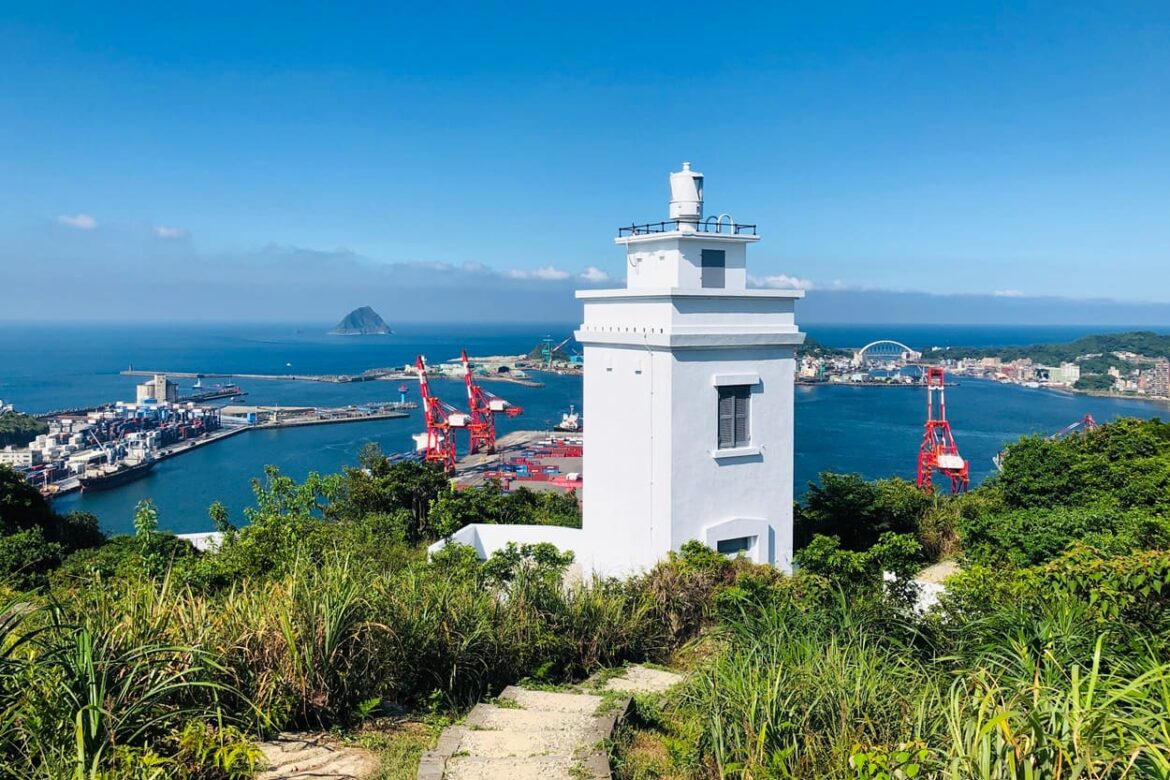Chiutzushan Lighthouse (球子山燈塔) stands as a testament to Taiwan‘s maritime history and architectural ingenuity. Perched atop Chiutzushan (also known as Fire Signal Mountain) on the western side of Keelung Harbor, this lighthouse has played a pivotal role in guiding vessels and now serves as a cherished landmark, offering panoramic views of the surrounding seascape.

History of the Chiutzushan Lighthouse
During the Japanese colonial period, in 1935, a wooden lamppost painted with black and white horizontal stripes was erected at the summit of Chiutzushan to warn against the submerged danger of Xinlai Reef (新瀨礁) outside the port of Keelung. However, it was later removed in 1948.

Chiutzushan Lighthouse, constructed in 1956, was the first lighthouse in Taiwan that was entirely designed and built by Taiwanese engineers. Its primary purpose was to align with the Keelung Lighthouse at the harbor’s entrance, assisting vessels in safely navigating in and out of Keelung Harbor. The lighthouse was strategically positioned to enhance maritime safety, particularly given the treacherous reefs that once surrounded the harbor.

After the demolition of Xinlai Reef in 1978, the lighthouse was decommissioned in 1991. Subsequently, the area surrounding the lighthouse was designated for military use due to its strategic location. During this period, the lighthouse, originally painted white, was repainted green to blend in with the surrounding army.

After the military vacated Chiutzushan, the local government recognized the site’s historical and touristic value. Restoration efforts were undertaken, and the lighthouse was repainted in its original white hue. The surrounding area was also renovated to enhance accessibility and visitor experience, leading to its official opening to the public in 2018.
Watch the following video on “Exploring Chiutzushan Lighthouse: Taiwan’s First Locally-Built Lighthouse” for more interesting images.
Chiutzushan: A strategic and historical landmark
Chiutzushan, standing at an elevation of 133 meters above sea level, has long been recognized for its strategic significance. During the Qing Dynasty, forts were constructed on this hill to defend against naval invasions. Before establishing the lighthouse, tar was burned on the hilltop as a signal to guide ships — a practice that earned it the name “Fire Signal Mountain” (火號山). This signaling method was crucial when modern navigational aids were not yet available.
In addition to its maritime significance, Chiutzushan played a notable role during the Franco-Chinese War. It was the first spot seized by the Spanish and was later illicitly sold to German merchants, reflecting the complex colonial interactions that have shaped Taiwan’s history.

Architectural features of the Chiutzushan Lighthouse
The lighthouse itself is a rectangular structure, standing 11.9 meters tall. Its altitude, measured from high tide to the center of the beacon, is 122.2 meters. Notably, it is one of only two rectangular lighthouses in Taiwan, the other being Su’ao Lighthouse, which was built in 1927. This unique design sets it apart from the more common cylindrical lighthouse structures found elsewhere.

The tower is constructed of concrete and was originally painted white. During the military occupation, it was repainted green for camouflage purposes. However, restoration efforts have returned it to its original white, allowing it to stand out strikingly against the backdrop of the deep blue sea.

Panoramic views and visitor experiences
The spacious hilltop of Chiutzushan offers visitors sweeping 360-degree views of Keelung Harbor and its environs. From the northeast side of the hilltop, the bright white lighthouse stands out beautifully against the azure sea. On clear days, one can see Heping Island, Keelung Islet, and the graceful arched Sheliao Bridge on Heping Island in the distance.

On the opposite side of the harbor, the panoramic view features Keelung Zhongzheng Park, crowned by its majestic statue of a goddess. The sight of ships quietly entering and exiting the harbor, along with the gentle swaying of reeds on the slopes, creates a serene and beautiful scene of grandeur. These picturesque vistas have made the lighthouse a popular spot for photography enthusiasts and nature lovers.
Restoration and conservation efforts
Recognizing the cultural and historical significance of Chiutzushan Lighthouse, the Keelung City Government initiated restoration projects to preserve and promote this landmark. The lighthouse was repainted to its original white, and pathways leading to it were improved to facilitate visitor access. These efforts have transformed the site into a recreational destination, allowing the public to appreciate its historical context and natural beauty.
The restoration of lighthouses like Chiutzushan is part of a broader trend in Taiwan and globally, where historical maritime structures are preserved for their navigational legacy and cultural and touristic value. Such initiatives ensure that future generations can connect with the maritime heritage that has shaped coastal communities.
Chiutzushan Lighthouse symbolizes Taiwan’s rich maritime history, architectural uniqueness, and enduring spirit of preservation. From its inception as a guiding beacon for vessels to its current role as a modern tourist attraction, the lighthouse embodies the dynamic interplay between functionality and heritage. Visitors to Chiutzushan are not only treated to breathtaking views but also embark on a journey through time, exploring the narratives that have shaped this remarkable landmark.
Follow us on X, Facebook, or Pinterest

